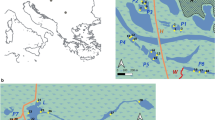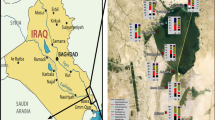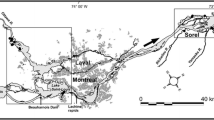Abstract
During the early 1900s, more than 90% of the surface area of Cootes Paradise Marsh was covered with emergent vegetation; currently, less than 15% of the surface is covered with aquatic vegetation and the remainder is wind-swept, turbid, open water. The loss of emergent cover is significantly correlated with mean annual water levels that increased more than 1.5 m over the past 60 years. Species diversity and the percent cover of the submerged macrophtye community also declined dramatically after the 1940s, coincident with decreased water clarity and increased nutrients from pollution by sewage and stormwater effluent. Phosphorus levels in the marsh dropped ten-fold after the sewage plant was upgraded to a tertiary-treatment facility in 1978; however, there was no measurable improvement in water clarity, in spite of a decrease in chlorophyll concentrations. Long-term changes in the composition of the planktonic, benthic and fish communities accompanied changes in water clarity, nutrient status and macrophyte cover. Phytoplankton changed from a community dominated by diverse taxa of green algae and diatoms during the 1940s, to a less diverse community dominated by a few taxa of green and blue-green algae in the 1970s, then to a much more diverse community recently, including many taxa of green algae, diatoms and chrysophytes; however, because water turbidity continues to be high, and algae tolerant of low light levels are now very abundant. Daphnia, which were prominent during the 1940s (especially in the vegetated sites) were replaced in the 1970s by smaller zooplankton such as the cladoceran, Bosmina, and several rotifer species including Brachionus, Asplanchna and Keratella. In the recent survey conducted in 1993 and 1994, small-bodied forms still dominate the turbid open-water areas, while medium-sized cladocerans such as Moina were common near macrophyte beds. Generally, total herbivorous zooplankton biomass tended to be highest next to Typha beds and declined with increasing distance from the plants. Conversely, biomass of edible algae at these sites increased with distance from the macrophytes. Species diversity of aquatic insects declined dramatically over the past 40 years, from 57 genera (23 families and 6 orders) in 1948, to 9 genera (6 families and 3 orders) in 1978, to only 5 genera (3 families and 2 orders) in 1995. The diverse benthic community present 5 decades ago has now been replaced by a community consisting primarily of chironomid larvae, oligochaetes and other worms associated with low-oxygen environments. These successional changes illustrate the impact of natural (fluctuating water levels) and anthropogenic (deterioration in water quality) stressors on the character of the biotic communities, and reveal the complex interactions among the various trophic levels and the abiotic environment as degradation and remediation proceeded.
Similar content being viewed by others
References
Bacchus, H. 1974. An ecological study of Cootes Paradise. M.Sc. Thesis, McMaster University, Hamilton, Ontario 220 pp.
Beklioglu, M. and Moss, B. 1996a. Existence of a macrophyte-dominated clear water state over a very wide range of nutrient concentrations in a small shallow lake. Hydrobiol. 337: 93-106.
Beklioglu, M. and Moss, B. 1996b. Mesocosm experiments on the interaction of sediment influence, fish predation and aquatic plants with the structure of phytoplankton and zooplankton communities. Freshwat. Biol. 36: 315-325.
Borchardt, D. and Statzner, B. 1990. Ecological impact of urban stormwater runoff studied in experimental flumes: population loss by drift and availability of refugial space. Aquat. Sci. 52: 299-314.
Breukelaar, A.W., Lammens, E.H.R.R., Breteler, J.G. and Tatrai, I. 1994. Effects of benthivorous bream (Abramis brama) and carp (Cyprinus carpio) on sediment resuspension and concentrations of nutrients and chlorophyll a. Freshwater Biol. 32: 113-121.
Bronmark, C. and Weisner, S.E.B. 1992. Indirect effects of fish community structure on submerged vegetation in shallow, eutrophic lakes: an alternative mechanism. Hydrobiologia 243/244: 293-301.
Butler, R.S., Moyer, E.J., Hukon, M.W. and Williams, V.P. 1992. Littoral zone invertebrate communities are affected by a habitat restoration project on Lake Tohopekaliga, Florida. J. Fresh. Ecol. 7: 317-328.
Casselman, J.M. and Harvey, H.H. 1975. Selective fish mortality resulting from low winter oxygen. Verh. int. Ver. Limnol. 19: 2418-2429.
Chambers, P. and Kalff, J. 1985. Depth distribution and biomass of submerged aquatic macrophyte communities in relation to Secchi-depth. Can. J. Fish. aquat. Sci. 45: 1010-1017.
Chambers, P. and Kalff, J. 1987. Light and nutrients in the control of aquatic plant community structure. J. Ecol. 75: 611-619.
Chapman, D. 1992. Water quality assessments: a guide to the use of biota, sediments and water in environmental monitoring. UNESCO/WHO/UNEP Chapman and Hall, 585 pp.
Chow-Fraser, P. 1986. An empirical model to predict in situgrazing rates of Diaptomus minutusLilljeborg on small algal particles. Can. J. Fish. aquat. Sci. 43: 1065-1070.
Chow-Fraser, P. and Knoechel, R. 1985. Factors regulating in situfiltering rates of Cladocera. Can. J. Fish. aquat. Sci. 42: 567-576.
Chow-Fraser, P. and Lukasik, L. 1995. Community participation in the restoration of a Great Lakes coastal wetland. Restoration and Management Notes 13: 183-189.
Chow-Fraser, P., Crosbie, B., Bryant, D. and McCarry, B. 1996. Potential contribution of nutrients and polycyclic aromatic hydrocarbons from the creeks of Cootes Paradise Marsh. Water Qual. Res. J. Canada 31: 485-503.
Cline, J.M., East, T.L. and Threlkeld, S.T. 1994. Fish interactions with the sediment-water interface. Hydrobiologia. 275/276: 301- 311.
Crivelli, A.J. 1983. The destruction of aquatic vegetation by carp. Hydrobiologia 106: 37-41.
Crosbie, B. and Chow-Fraser, P. manuscript. Moving past the wetland boundary: how altered landuse in the watershed affects the water quality and vegetation in wetlands. Can. J. Fish. Aquat. (in review)
Crowder, A. and Bristow, M. 1986. Aquatic macrophytes in the Bay of Quinte. Can. Spec. Publ. Fish. Aquat. Sci. 86: 114-127.
Crowder, A. and Painter, D.S. 1991. Submerged macrophytes in Lake Ontario: current knowledge, importance, threats to stability and needed studies. Can. J. Fish. aquat. Sci. 48: 1539-1545.
Cyr, H. and Downing, J.A. 1988. The abundance of phytophilous invertebrates on different species of submerged macrophytes. Fresh. Biol. 20: 365-374.
Denny, P. 1994. Biodiversity and wetlands. Wetlands Ecology and Management 3: 55-61.
Dieter, C.D. 1990. The importance of emergent vegetation in reducing sediment resuspension in wetlands. J. Fresh. Ecol. 5: 467-473.
Ehrenfeld, J.G. 1983. The effects of changes in land-use on swamps of the New Jersey Pine Barrens. Biol. Conserv. 25: 353-375.
Engel, S. and Nicholas, S. A. 1994. Aquatic macrophyte growth in a turbid windswept lake. J. Fresh. Ecol. 9: 97-109.
Fitzgerald, E. 1996. Diet of pumpkinseed sunfish (Lepomis gibbosus) and brown bullhead (Amerius nebulosus) in the littoral zone of Hamilton Harbour. M.Sc. Thesis, McMaster University, Hamilton, Ontario.
Haines, T.A. 1973. Effects of nutrient enrichment and a rough fish population (Carp) on a game fish population (Smallmouth Bass). Trans. am. Fish. Soc. 2: 346-354.
Hansen, A-M., Andersen, F.O., and Jensen, H.S. 1997. Seasonal pattern in nutrient limitation and grazing control of the phytoplankton community in a non-stratified lake. Freshwat. Biol. 37: 523-534.
Hanson, J.M. 1990. Macroinvertebrate size-distributions of two contrasting freshwater macrophyte communities. Freshwat. Biol. 24: 481-491.
Hanson, M.A. and Butler, M.G. 1990. Early responses of plankton and turbidity to biomanipulation in a shallow prairie lake. Hydrobiologia 200/201: 317-327.
Harris, G.P. and Bacchus, H.M. 1974. Chlorophyll and production in a polytrophic marsh. Proc. 9th Canadian Symposium. 1974: Water Poll. Res. Canada.
Harris, S.W. and Marshall, W.H. 1963. Ecology of water-level manipulations on a northern marsh. Ecology 44: 331-343.
Holmes, J.A. 1988. Potential for fisheries rehabilitation in the Hamilton Harbour-Cootes Paradise Ecosystem of L. Ontario. J. Great Lakes Res. 14: 131-141.
Holmes, J.A. and Whillans, T.H. 1984. Historical review of Hamilton Harbour fisheries. Can. Tech. Rep. Fish. Aquat. Sci. 1498.
Hough, R.A., Fornwall, M.D., Negele, B.J., Thompson, R.L. and Putt, D.A. 1989. Plant community dynamics in a chain of lakes: principal factors in the decline of rooted macrophytes with eutrophication. Hydrobiologia 173: 199-217.
Hurley, D.A. 1986. Fish populations of the Bay of Quinte, Lake Ontario, before and after phosphorus control. Can. Spec. Publ. Fish. aquat. Sci. 86: 201-214.
Irvine, K., Moss, B. and Balls, H. 1989. The loss of submerged plants with eutrophication II. Relationships between fish and zooplankton in a set of experimental ponds, and conclusions. Freshwat. Biol. 22: 89-107.
Judd, W.W. 1955. A study of the population of insects emerging as adult from the Dundas Marsh, Hamilton, Ontario, during 1948. Am. Midl. Nat. 49: 801-824.
Jude, D.J. and Pappas, J. 1992. Fish utilization of Great Lakes coastal wetlands. J. Great Lakes Res. 18: 651-672.
Kay, R.M. 1949. Limnological studies of the Dundas Marsh Region. M.A. Thesis, McMaster University, Hamilton, Ontario.
Keddy, P. and Reznicek, A.A. 1986. Great Lakes vegetation dynamics: the role of fluctuating water levels and buried seeds. J. Great Lakes Res. 12: 25-36.
Kelley, J.C., Burton, T.M. and Enslin, W.R. 1985. The effects of water level fluctuations on N and P cycling in a Great Lakes Marsh. Wetlands 4: 159-176.
Klarer, D.M. and Millie, D.F. 1994. Regulation of phytoplankton dynamics in a Laurentian Great Lakes estuary. Hydrobiologia 286: 97-108.
Krieger, K.A. 1992. The ecology of invertebrates in Great Lakes coastal wetlands: current knowledge and research needs. J. Great Lakes Res. 18: 634-650.
Krieger, K.A. and Klarer, D.M. 1991. Zooplankton dynamics in a Great Lakes Coastal Marsh. J. Great Lakes Res. 17: 255-269.
Krieger, K., Klarer, D.M., Heath, R.T. and Herdendorf, C.E. 1992. Coastal wetlands of the Laurentian Great Lakes: current knowledge and research needs. J. Great Lakes Res. 18: 525-528.
Lamarra, V.A. 1975. Digestive activities of carp as a major contributor to the nutrient loading of lakes. Verh. int. Ver. Limnol. 19: 2461-2468.
Lamoureux, W.J. 1957. Aquatic plants for fish and wildlife. A conservation bulletin sponsored by the Toronto Anglers and Hunters Association.
Lauridsen, T.L. and Buenk, I. 1996. Diel changes in the distribution of zooplankton in the littoral zone of two shallow eutrophic lakes. Arch. Hydrobiol. 137: 161-176.
Lauridsen, T.L. and Lodge, D.M. 1996. Avoidance of Daphnia magnaby fish and macrophytes: chemical cues and predator-mediated use of macrophyte habitat. Limnol. Oceanogr. 41: 794-798.
Lavender, B. 1987. Historical geography of Cootes Paradise, Ontario. Senior Honours Thesis, Dept. of Geography, Univ. of Waterloo, Waterloo, Ontario.
Lord, J. 1993. Cootes Paradise as it was. Pappus 12: 29-33.
Lougheed, V.L. and Chow-Fraser, P. 1998. Factors that regulate the zooplankton community structure of a turbid, hypereutrophic Great Lakes wetland. Can. J. Fish. aquat. Sci. (in press).
Lougheed, V.L., Crosbie, B. and Chow-Fraser, P. 1998. Predictions on the effect of carp exclusion on water quality, zooplankton and submergent macrophytes in a Great Lakes wetland. Can. J. Fish. aquat. Sci. (in press).
Lyon, J. G., Asce, M. and Drobney, R.D. 1984. Lake level effects as measured from aerial photos. J. Surv. Eng. 110: 103-111.
Maltby, L., Forrow, D. M., Boxall, A.B., Calow, P. and Betton, C.I. 1995. The effects of motorway runoff on Fresh. Ecosystems. 1. Field Study. Env. Tox. Chem. 14: 1079-1092.
Maynard, L. and Wilcox, D. 1996. Coastal Wetlands of the Great Lakes: Background paper for State of the Lakes Conference (SOLEC). Environment Canada and U.S. Environmental Protection Agency. EPA 905-D-96-001c. 74 pp. + addendum.
McDonald, M.E. 1955. Cause and effects of a die-off of emergent vegetation. J. Wildl. Mgmt 19: 24-35.
McLarty, A. and Thachuk, A.G. 1986. Cootes Paradise Study. Water Resources Assessment Unit, Technical Support Section, West Central Region, Hamilton, Ontario Ministry of the Environment unpub. technical report.
Minns, C.K., Owen, G.E. and Johnson, M.G. 1986. Nutrient loads and budgets in the Bay of Quinte, Lake Ontario, 1965-81. Can. Spec. Publ. Fish. aquat. Sci. 86: 59-76.
Mitsch, W.J. and Reeder, B.C. 1991. Modelling nutrient retention of a freshwater coastal wetland: estimating the roles of primary productivity, sedimentation, resuspension and hydrology. Ecol. Mod. 54: 151-187.
Painter, D.S., L. Hampson and W.L. Simser. 1991. Cootes Paradise Water Turbidity: sources and recommendations National Water Research Institute Contribution No. 91-15.
Paterson, M. 1993. The distribution of microcrustacea in the littoral zone of a freshwater lake. Hydrobiologia 263: 173-183.
Pitt, R. and Bozeman, M. 1982. Sources of urban runoff pollution and its effects on an urban creek. EPA-600/S2-82-090, U.S. EPA, Cincinnati, Ohio.
Pitt, R., Field, R., Lalor, M. and Brown, M. 1995. Urban stormwater toxic pollutants: assessment, sources and treatability. Wat. Envir. Res. 67: 260-275.
Prince, H.H., Padding, P.I. and Knapton, R.W. 1992. Waterfowl use of the Laurentian Great Lakes 18: 673-699.
Randall, R.G., Minns, C.K., Cairns, V.W. and Moore, J.E. 1993. Effect of habitat degradation on the species composition and biomass of fish in Great Lakes Areas of Concern. Can. Tech. Rep. Fish. aquat. Sci. No. 1941. 38 pp.
Rasmussen, J.B. 1988. Littoral zoobenthic biomass in lakes, and its relationship to physical, chemical and trophic factors. Can. J. Fish. aquat. Sci. 45: 1436-1447.
Remedial Action Plan for Hamilton Harbour Stage 1 Report. 1992. Environmental conditions and problem definition, a Ontario-Canada publication, October 1992.
Roth, N.E., Allan, J.D. and Erikson, D.L. 1996. Landscape influences on stream biotic integrity assessed at multiple spatial scales. Landscape Ecol. 11: 141-156.
Sager, E. 1996. Factors influencing the light environment in Cootes Paradise, Hamilton Harbour, and other coastal marshes of L. Ontario. Wat. Qual. Res. J. Canada 31: 553-575.
Schriver, P., Bøgestrand, J., Jeppesen, E. and Søndergaard, M. 1995. Impact of submerged macrophytes on fish-zooplankton-phytoplankton interactions: large-scale enclosure experiments in a shallow eutrophic lake. Freshwat. Biol. 33: 255-270.
Semkin, R.G., McLarty, A.W. and Craig, D. 1976. A water quality study of Cootes Paradise. Water Resources Assessment, Technical Support Section, Ont. Min. Env.,West Central Region.
Sims, R.A. 1949. Phytoplankton studies of Cootes Paradise Marsh, Royal Botanical Gardens, Hamilton. M.A. Thesis, McMaster University, Hamilton, Ontario, 38 pp.
Simser, L. 1982. The Changes in the aquatic biota of Cootes Paradise. Royal Botanical Gardens Tech. Bull. No. 12. Burlington, Ont. Canada.
Skubinna, J.P., Coon, T.G. and Batterson, T.R. 1995. Increased abundance and depth of submersed macrophytes in response to decreased turbidity in Saginaw Bay, Lake Huron. J. Great Lakes Res. 21: 476-488.
Striegl, R.G. 1985. Effects of stormwater runoff on an urban lake, Lake Ellyn at Glen Ellyn, Illinois, USGS Open File Rep. 84-603, U.S. Geological Survey, Lakewood Colorado.
Tamsalu, A. 1953. The vegetation of the southern section of the Royal Botanical Gardens and perspectives for its development. Unpub. ms. in Royal Botanical archives.
Threinen, C.W. and Helm, W.T. 1954. Experiments and observations designed to show carp destruction of aquatic vegetation. J. Wildlife Managmt. 18: 247-250.
Timms, R.M. and Moss, B. 1984. Prevention of growth of potentially dense phytoplankton populations by zooplankton grazing, in the presence of zooplanktivorous fish, in a shallow wetland ecosystem. Limnol. Oceanogr. 29: 472-486.
Weisner, S.E.B. 1987. The relation between wave exposure and distribution of emergent vegetation in a eutrophic lake. Freshwat. Biol. 18: 537-544.
Whillans, T. 1982. Changes in marsh area along the Canadian shore of Lake Ontario. J. Great Lakes Res. 8: 570-577.
Whillans, T. 1996. Historic and comparative perspectives on rehabilitation of marshes as habitat for fish in the lower Great Lakes basin. Can. J. Fish. aquat. Sci. 53(Suppl 1): 56-66.
Wragg, L.E. 1949. The muskrat in southern Ontario. M. A. Thesis. University of Toronto, Toronto, Ontario.
Author information
Authors and Affiliations
Rights and permissions
About this article
Cite this article
Chow-Fraser, P., Lougheed, V., Le Thiec, V. et al. Long-term response of the biotic community to fluctuating water levels and changes in water quality in Cootes Paradise Marsh, a degraded coastal wetland of Lake Ontario. Wetlands Ecology and Management 6, 19–42 (1998). https://doi.org/10.1023/A:1008491520668
Issue Date:
DOI: https://doi.org/10.1023/A:1008491520668




